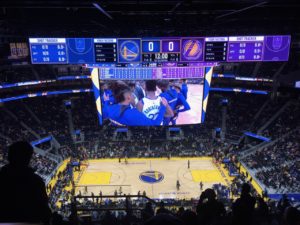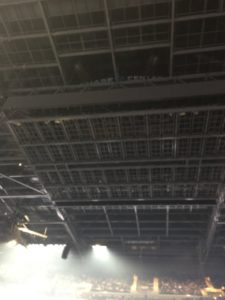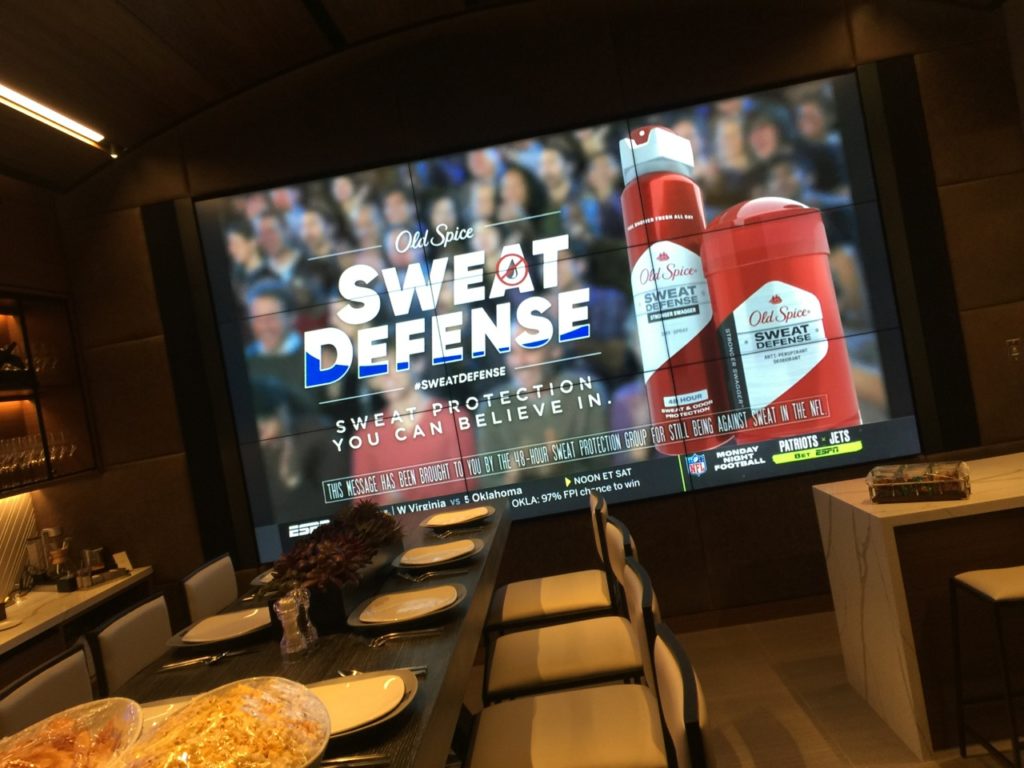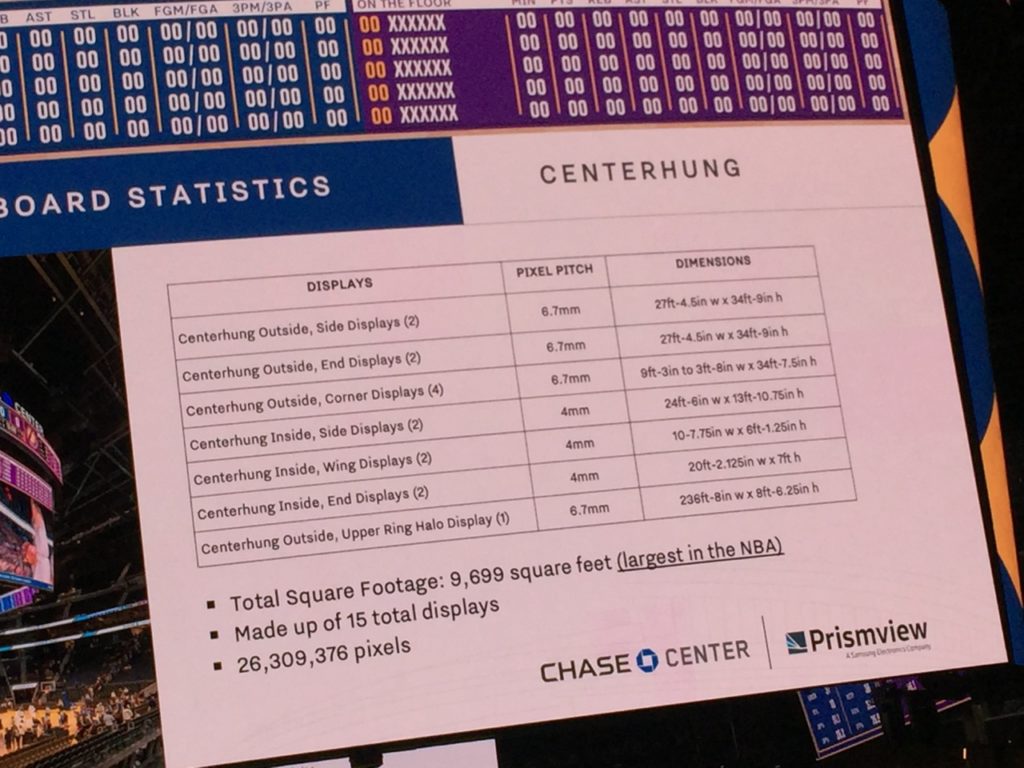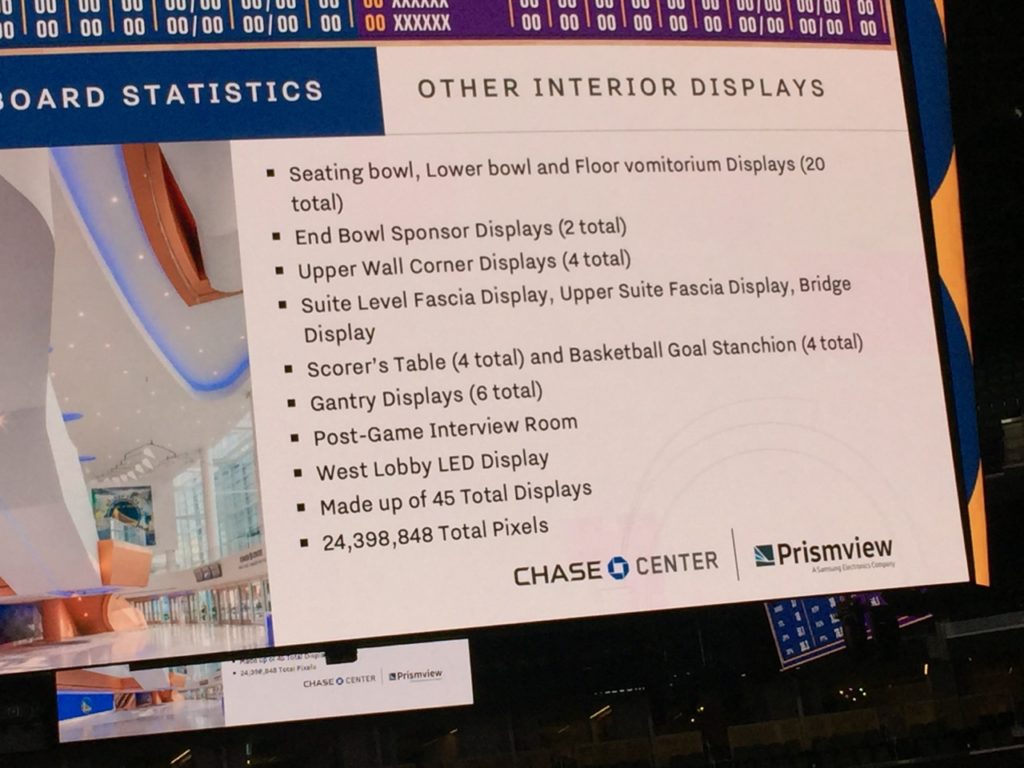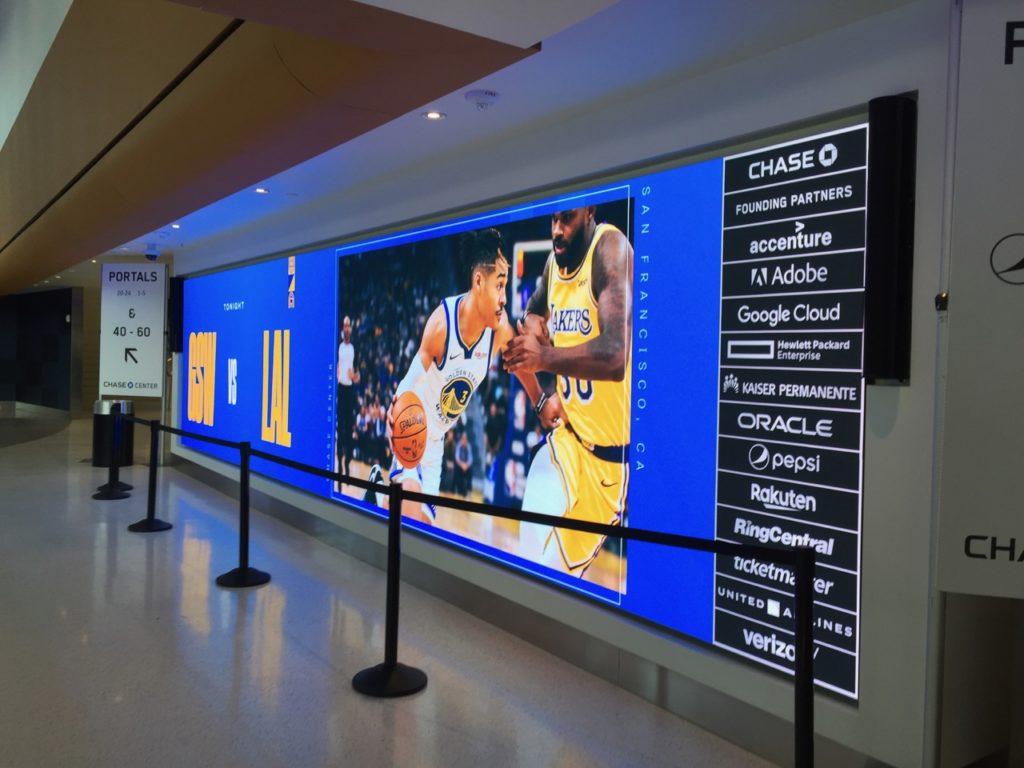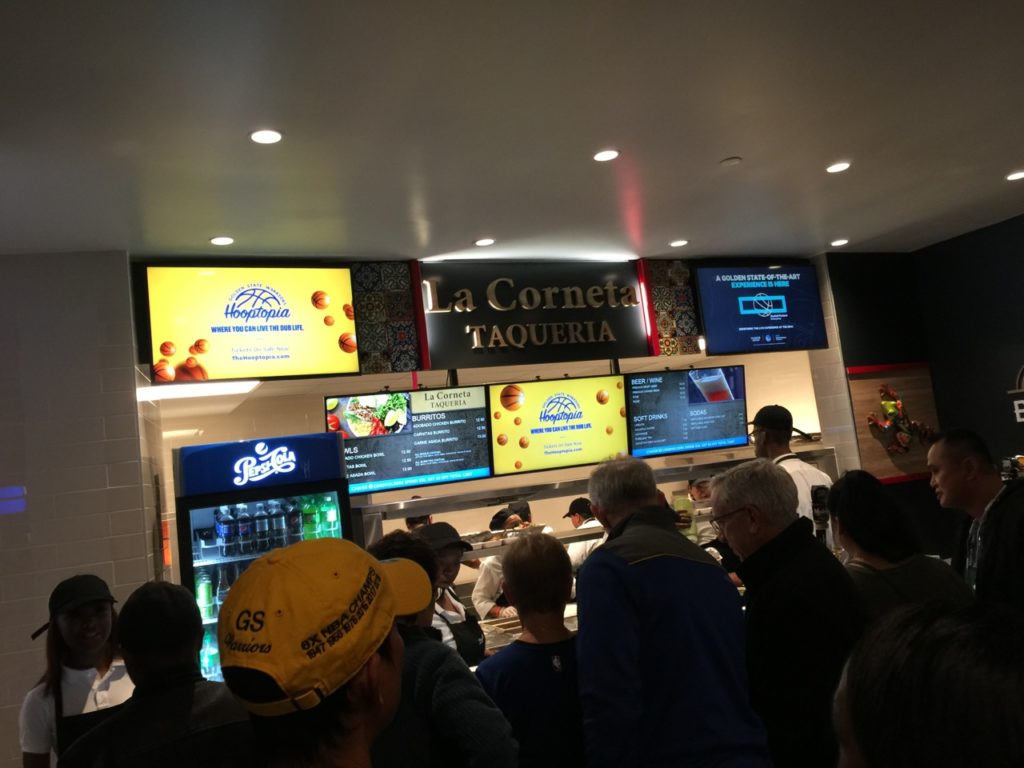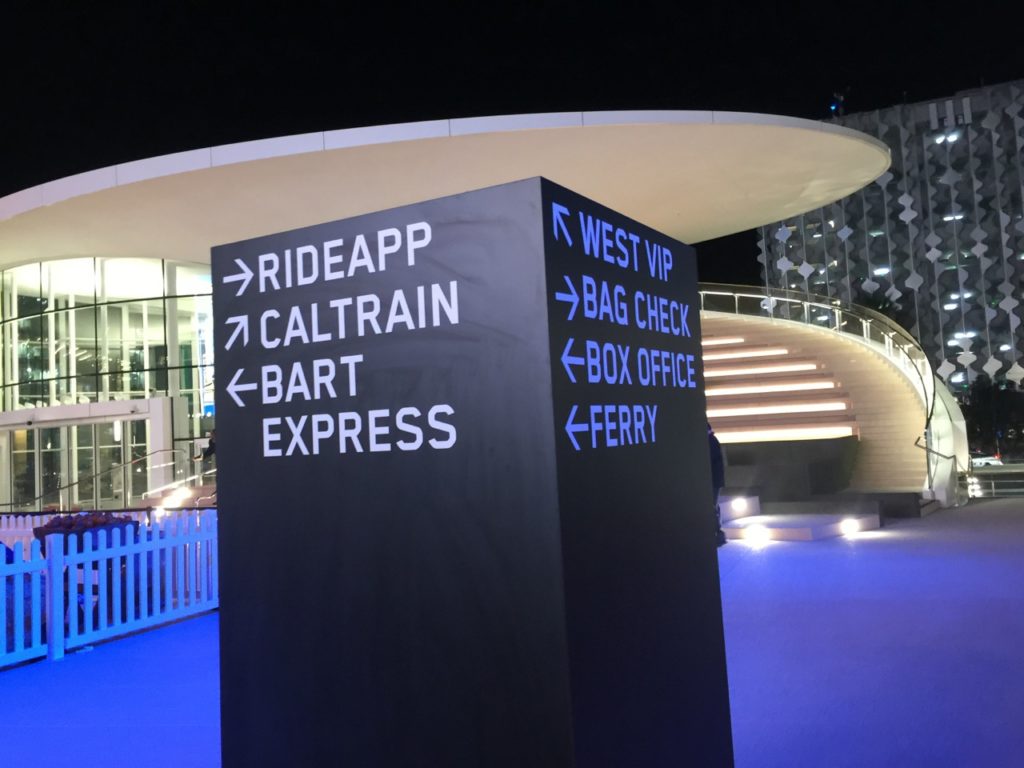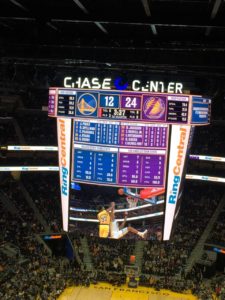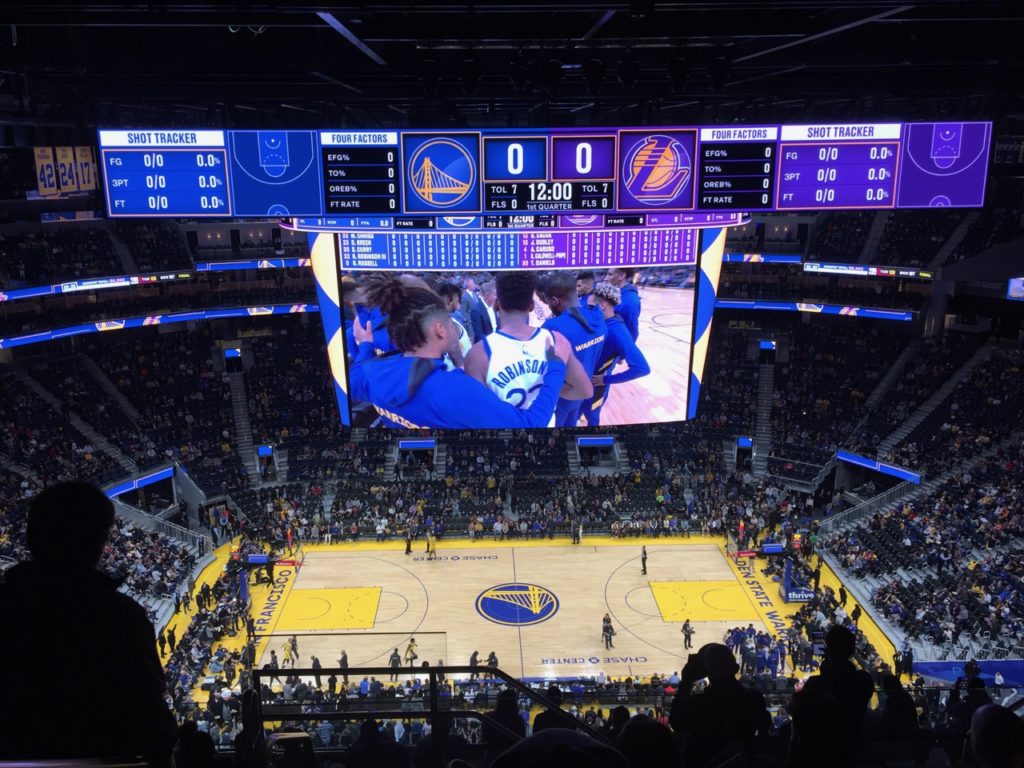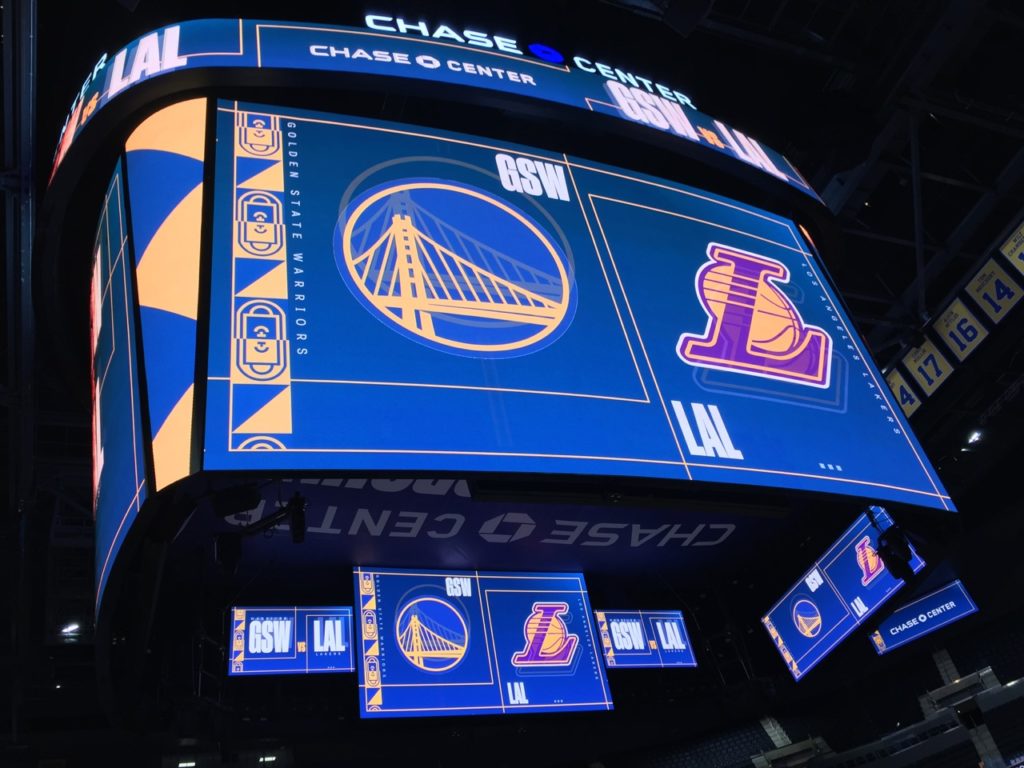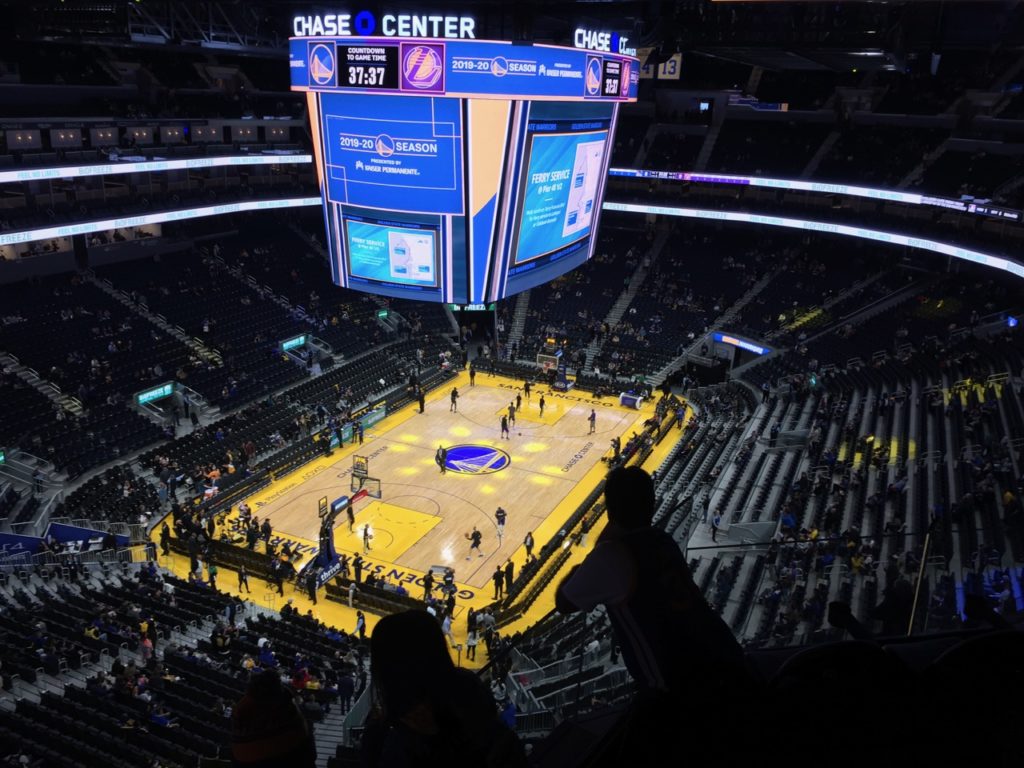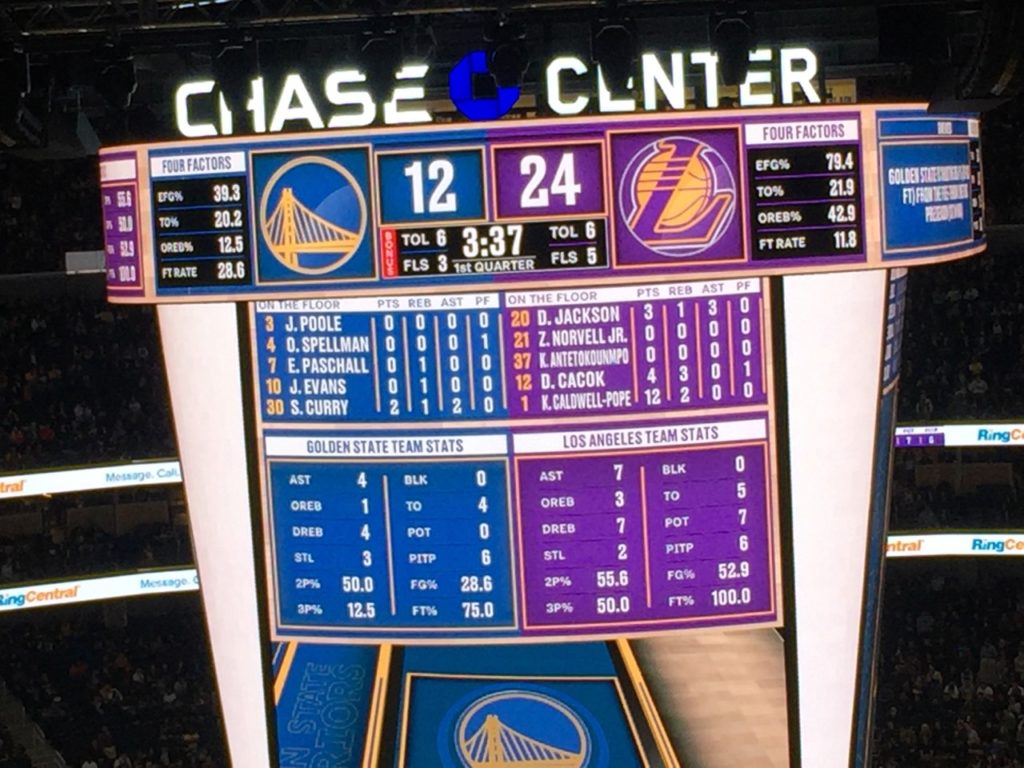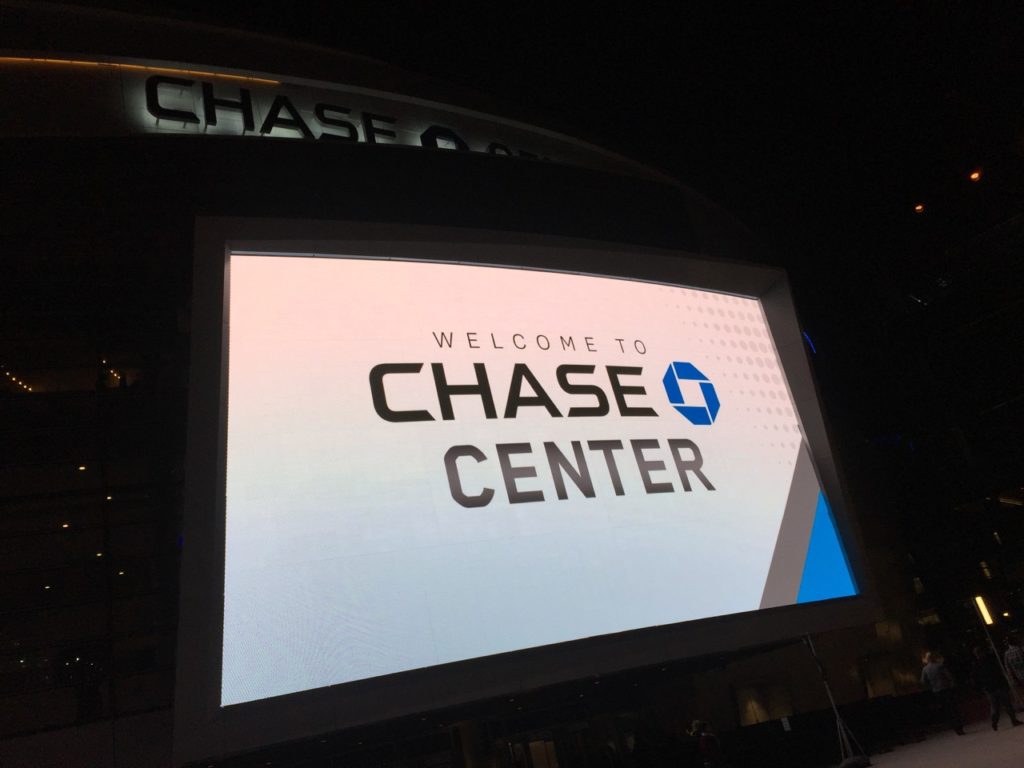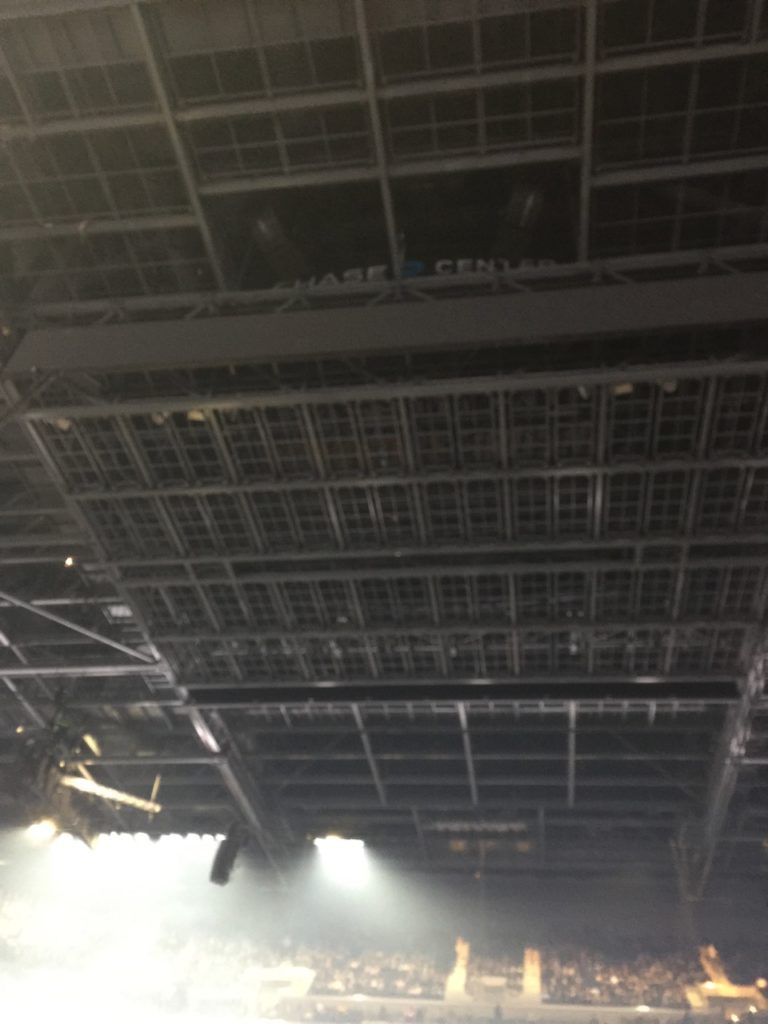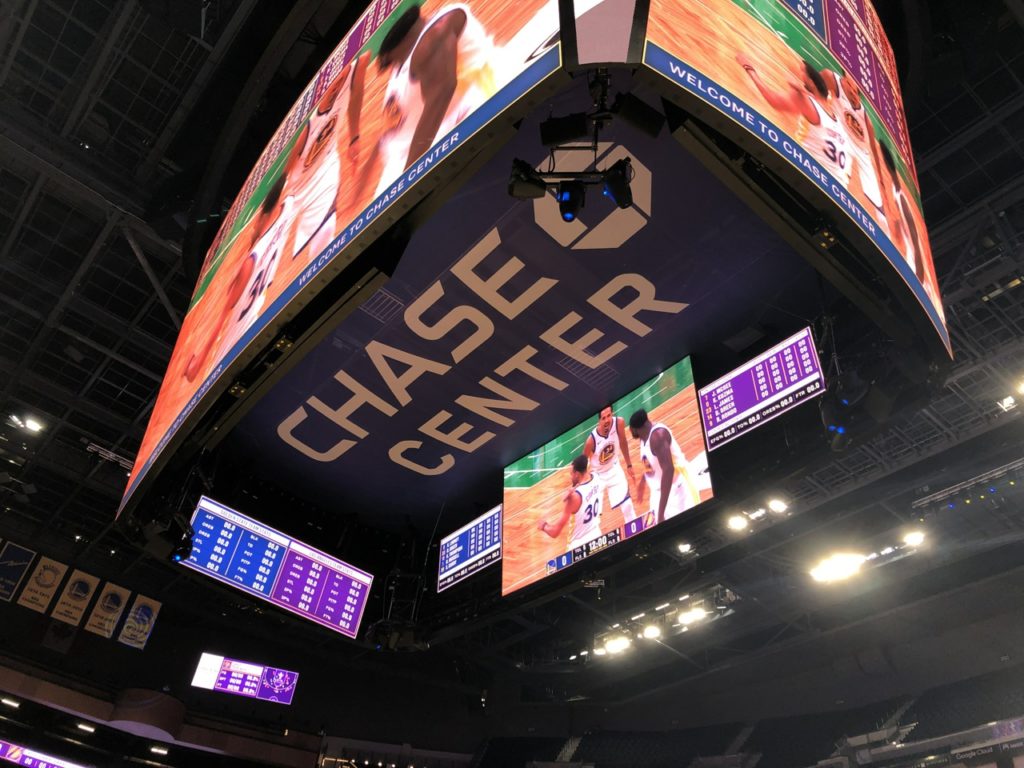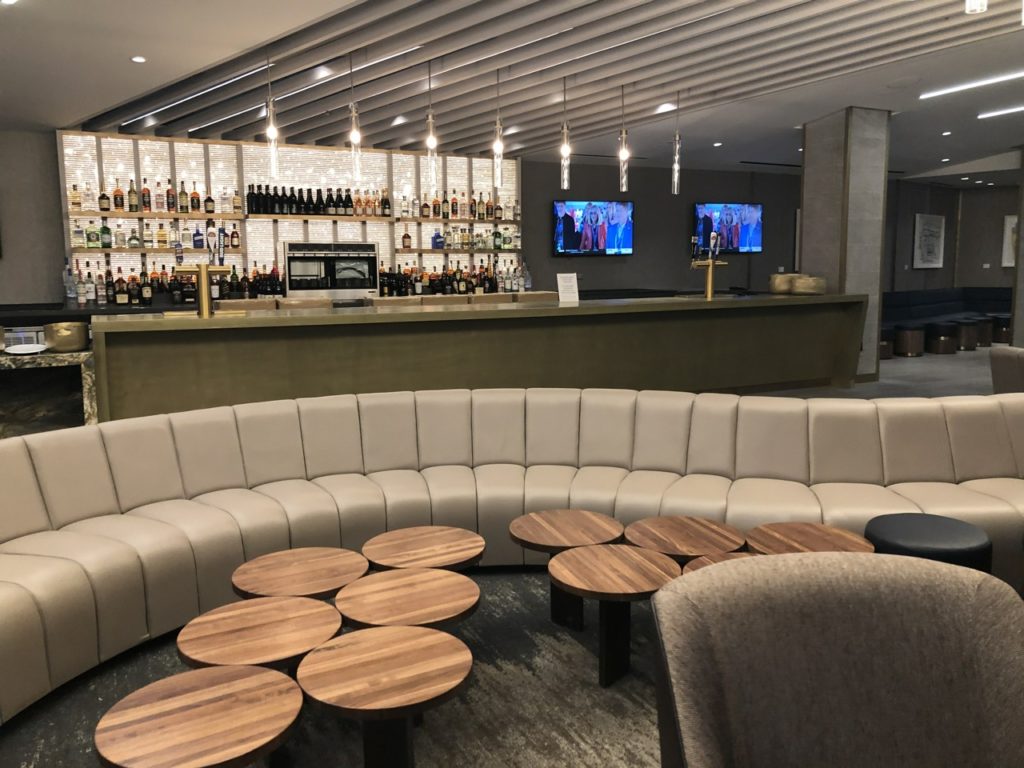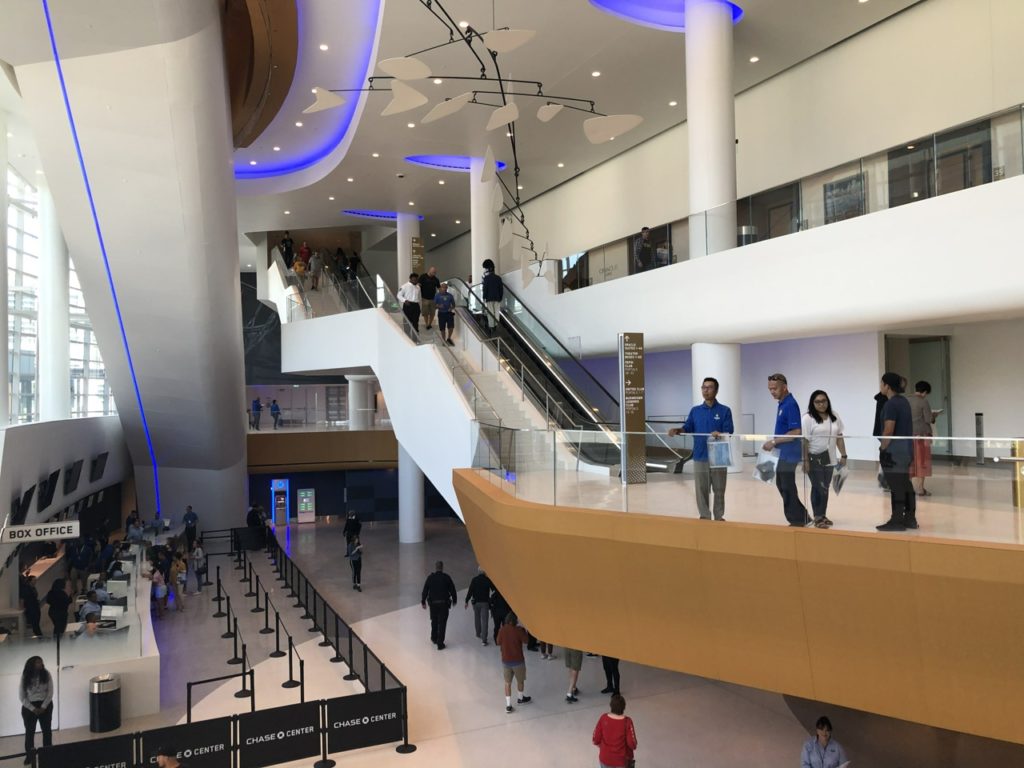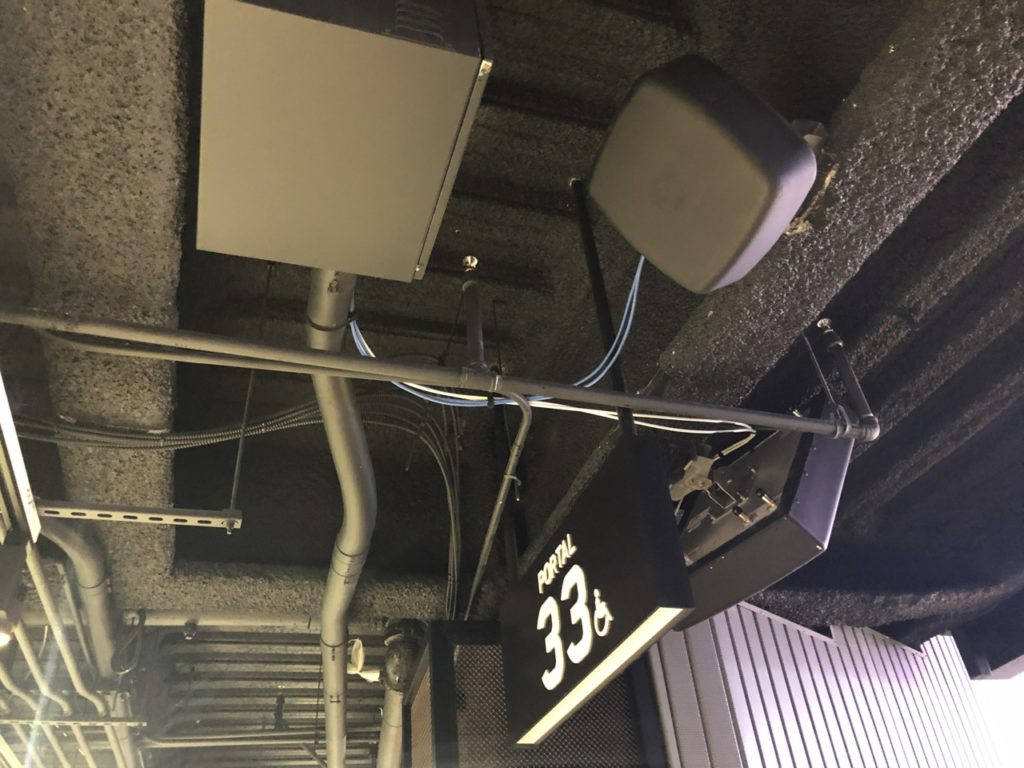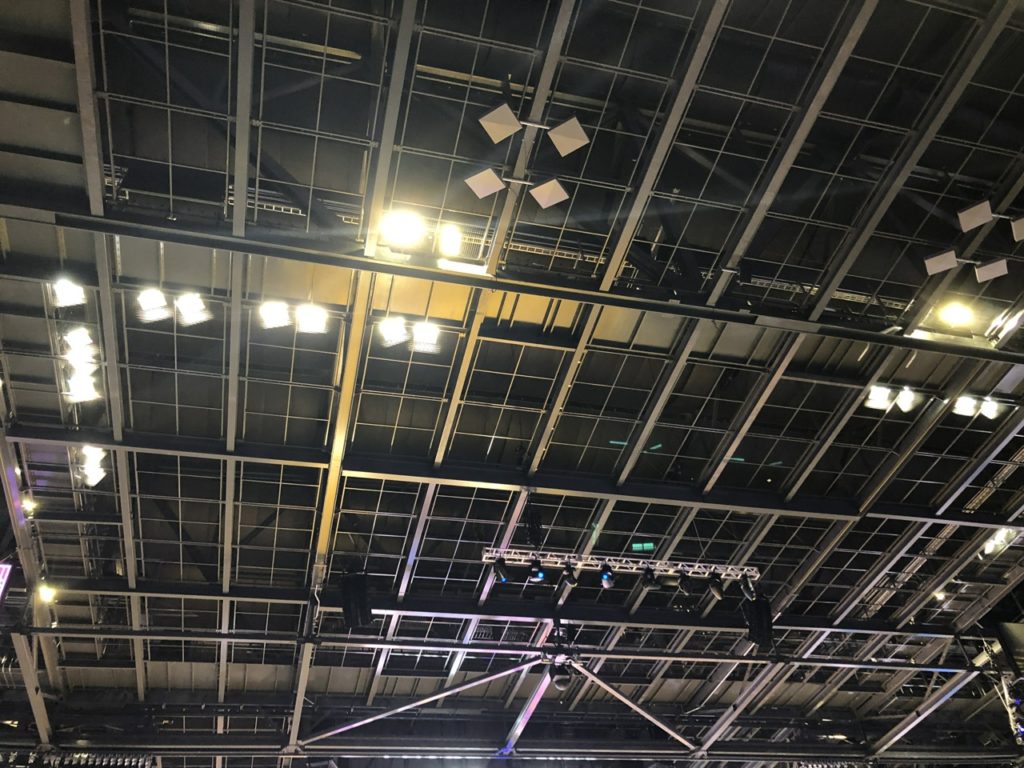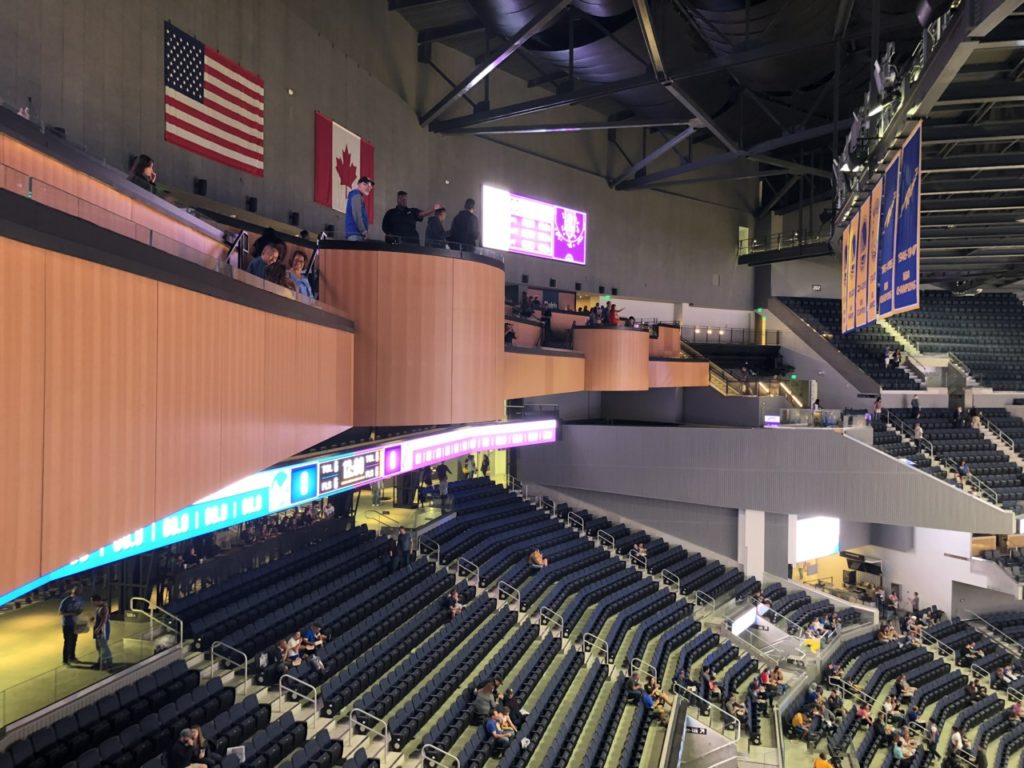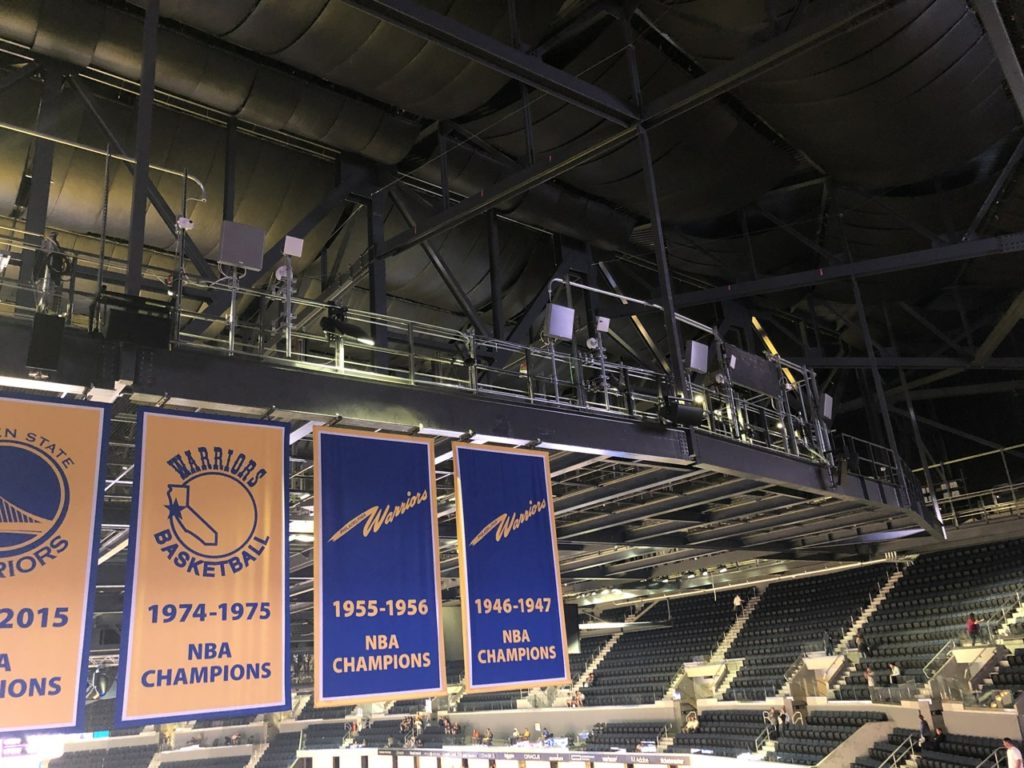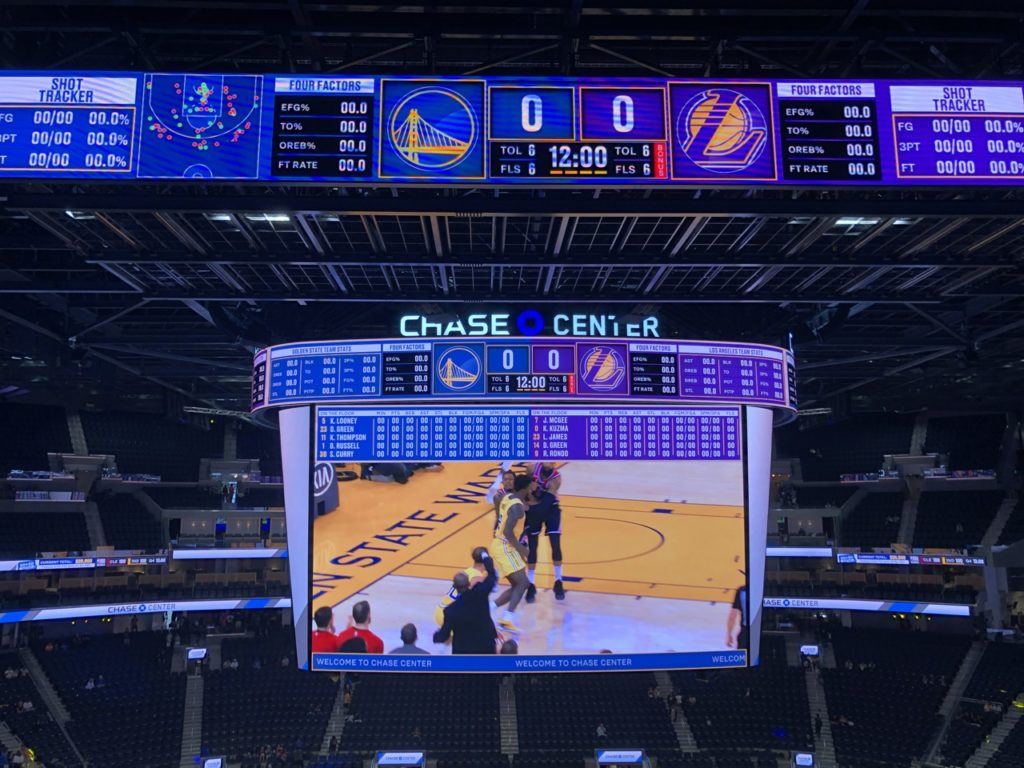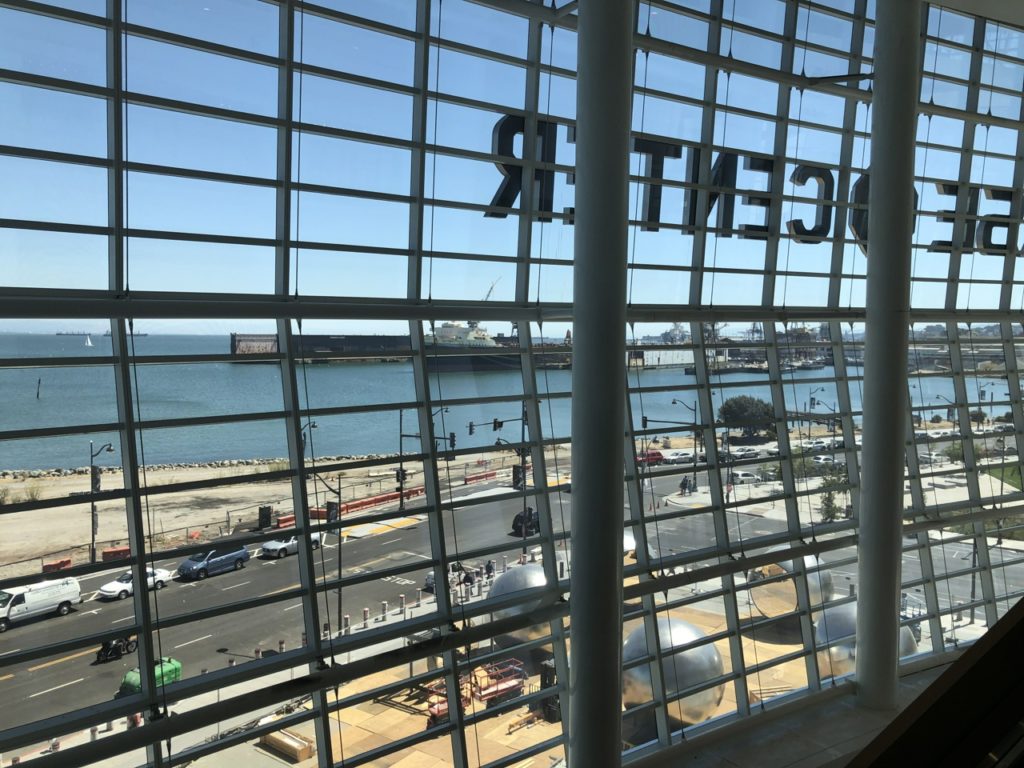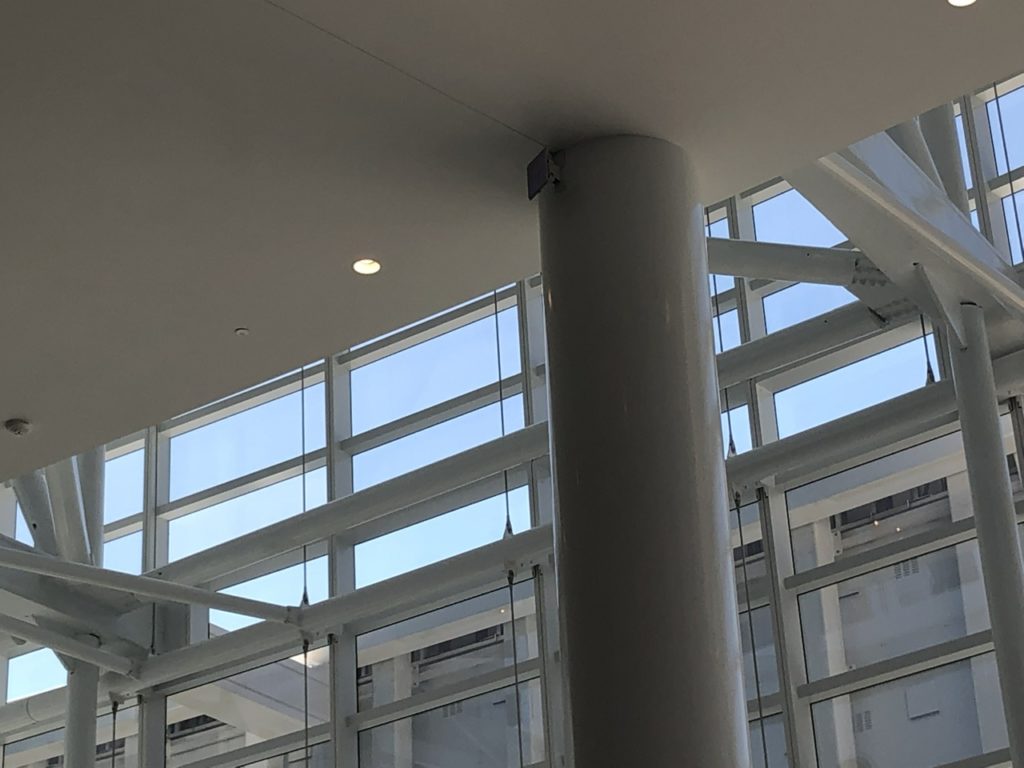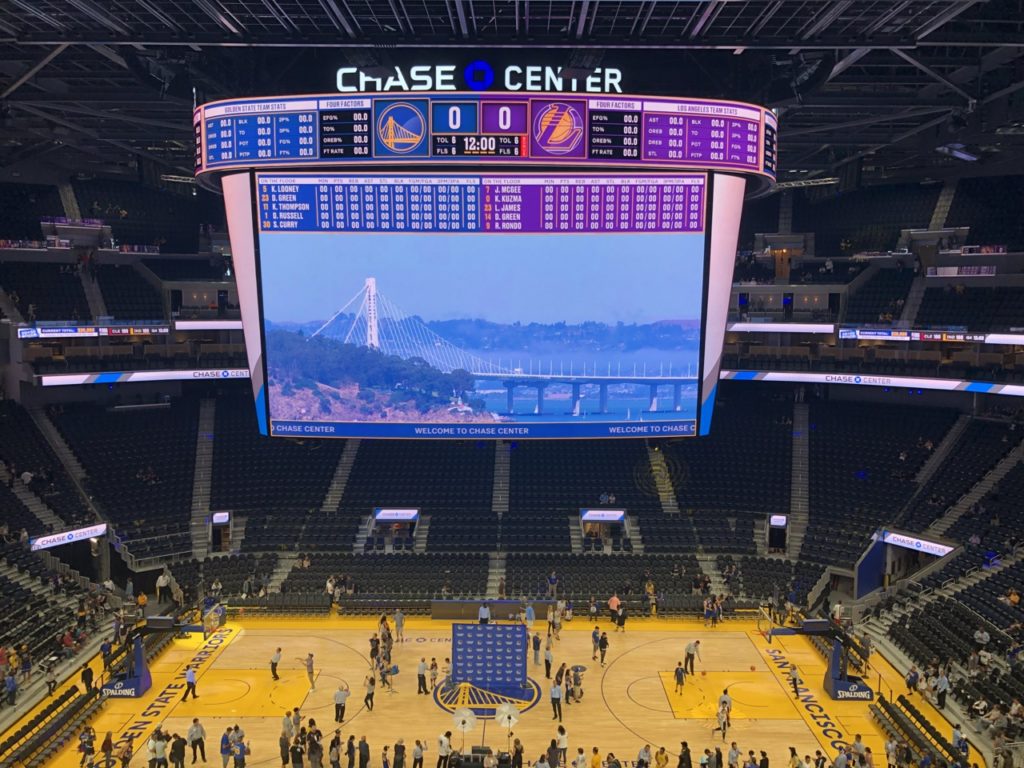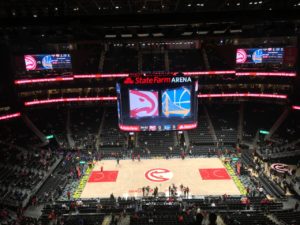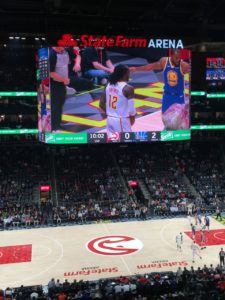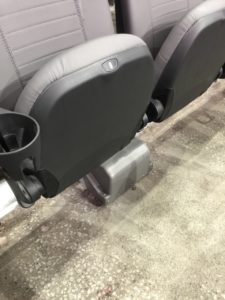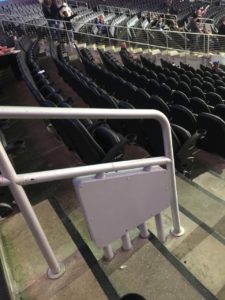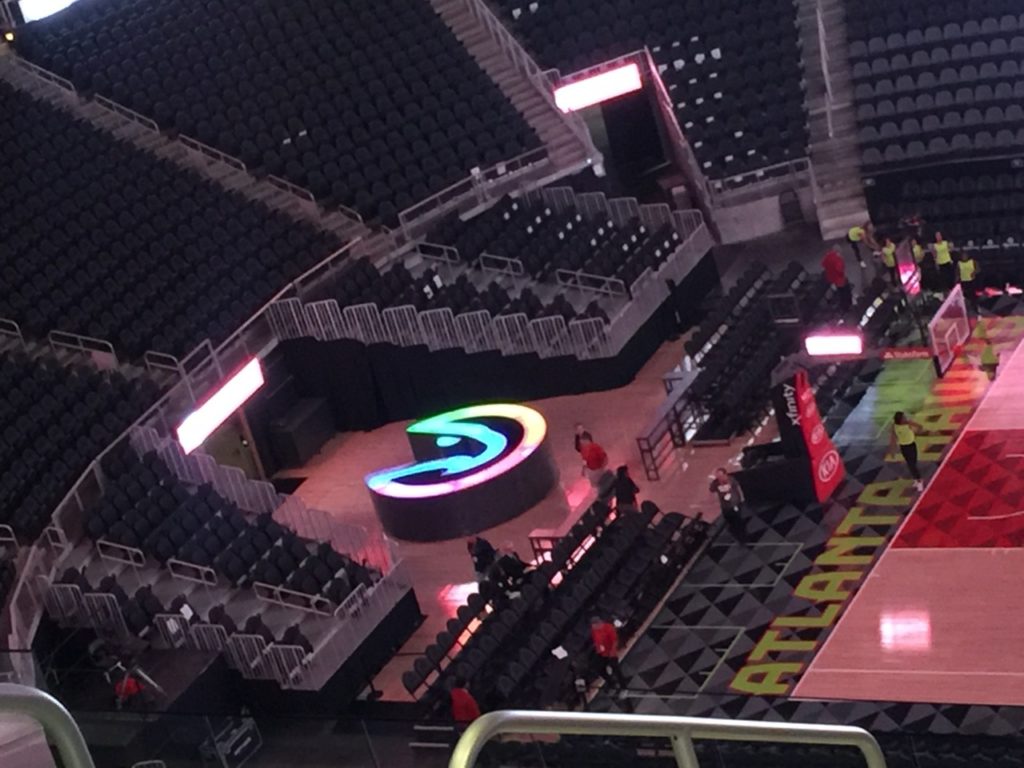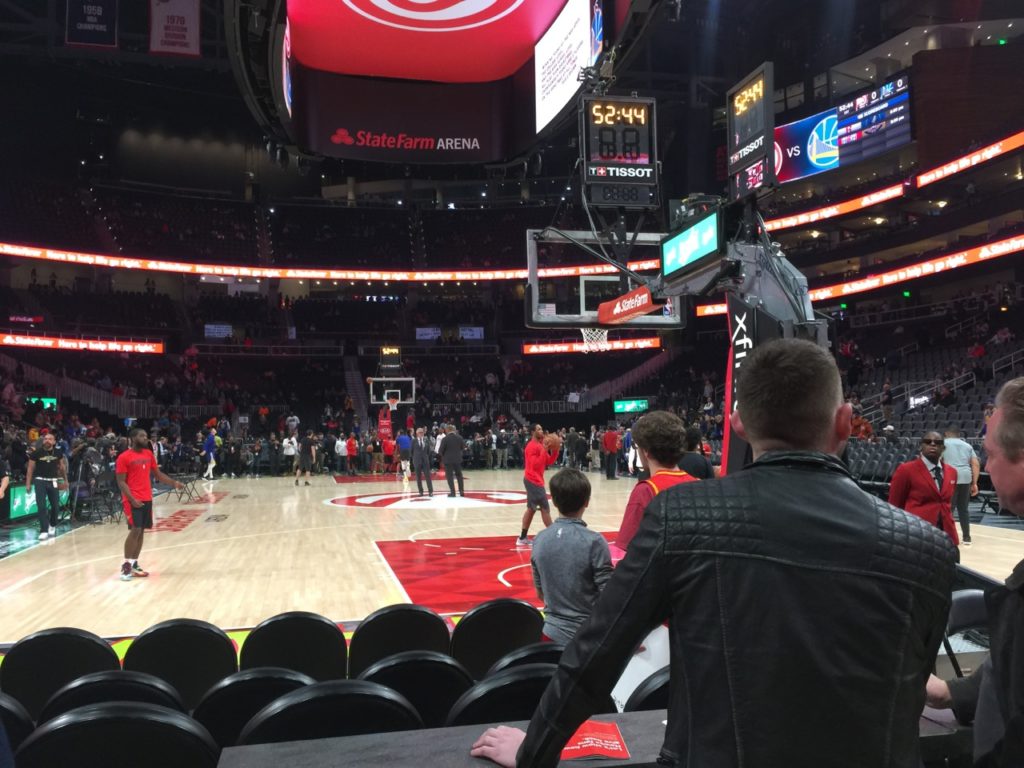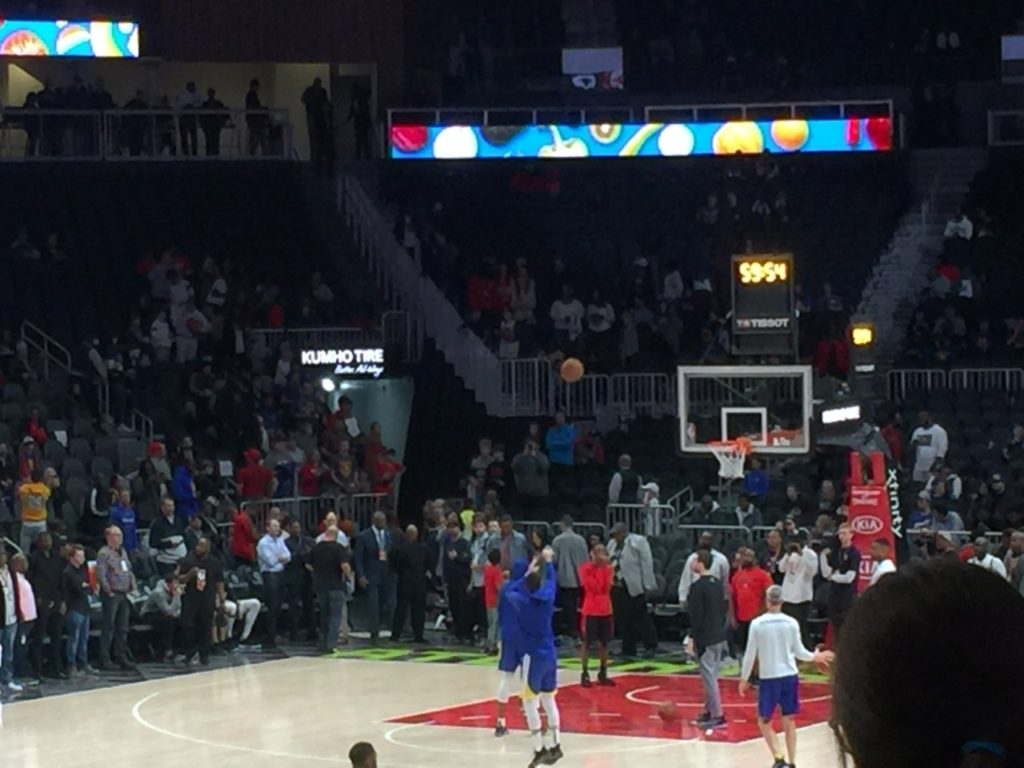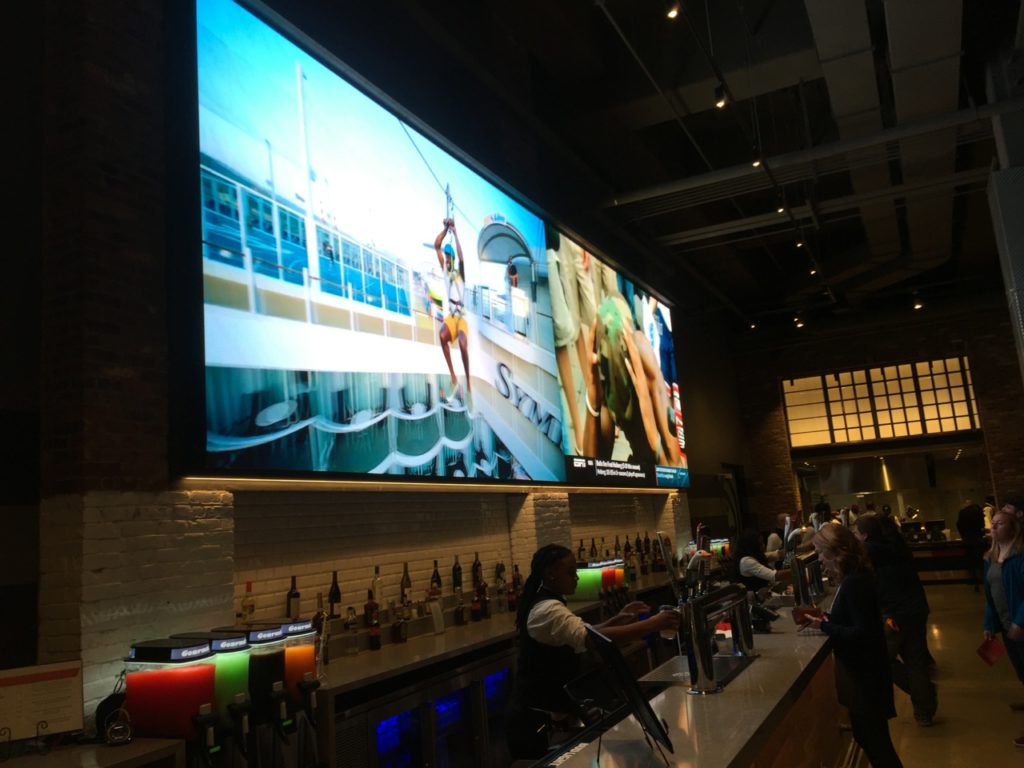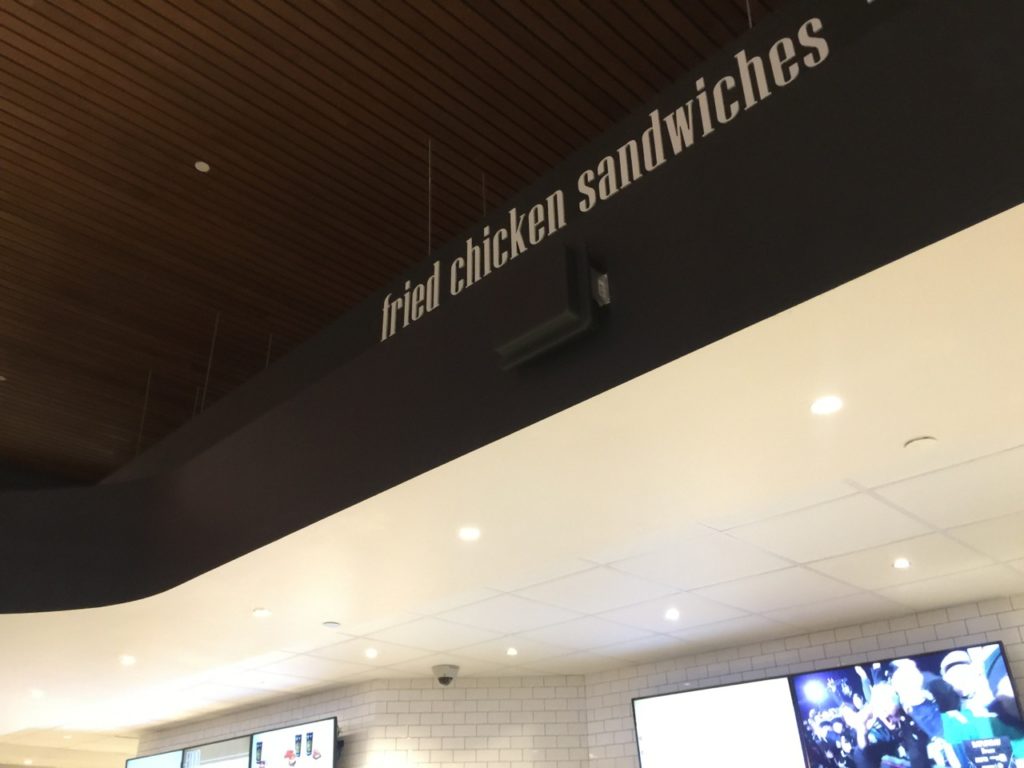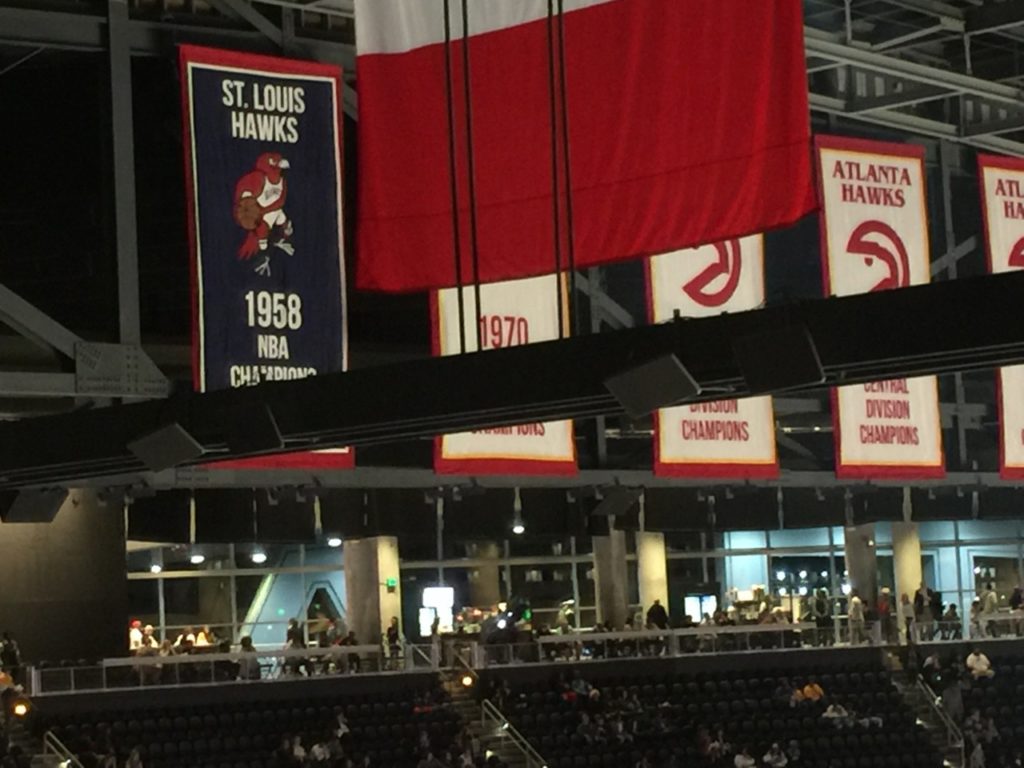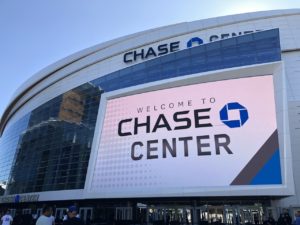
The exterior of Chase Center, with its humongous video board. Credit: Brian Nitenson, MSR (click on any picture for a larger image)
The the star of the show is the centerhung video board, a mammoth 9,699-square-foot display from Samsung’s Prismview with 15 separate boards, including ones underneath so the courtside fans don’t have to crane their necks too far upward. While the so-called “chandelier” dominates the view inside the Warriors’ new home, one hint that the Warriors are getting display restraint right is the fact that the board can be completely hidden if so desired, sucked up into a hiding hole in the ceiling. The hide-the-scoreboard trick seems to be proof that the Warriors care enough about the venue experience if it means they have to stow away their favorite toy every now and then.
In a mid-October 2019 visit to Chase Center, Mobile Sports Report can tell you that there is no missing the video displays inside the new $1.4 billion arena, which opened in September 2019 in San Francisco, just south of the San Francisco Giants’ Oracle Park alongside the San Francisco Bay. With 64 different video boards in total, which according to Samsung includes 53.6 million individual pixels – as well as another 1,100 Samsung LCD TV screens – Chase Center is as digitally visual as can be, with (according to the Warriors) 40 percent more display screen area than any other comparable-size venue.
The most pixels inside
Editor’s note: This profile is from our recent Venue Display Report, which you can view in its entirety online, with embedded videos and much better photography! You can also read about Chase Center’s wireless networking in our recent Stadium Tech Report, also available for instant online reading! When it comes to technology at Chase Center, there is no better in-depth resource than Mobile Sports Report!
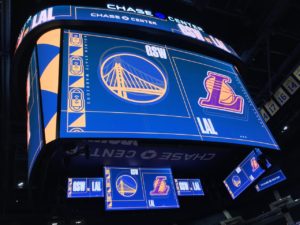
The impressive Chase Center centerhung video board from Samsung’s Prismview. Credit all following photos: Paul Kapustka, MSR
Inside the main bowl, the centerhung video board dominates all views, with its incredibly crisp (6.7mm pixel pitch) main screens. While all the numbers can be staggering, according to Warriors president and COO Rick Welts, the team didn’t install the biggest and brightest displays simply to win some kind of imaginary tech title.
Instead, he claims, it’s all about creating the best possible fan experience for a following that represents a unique confluence of events, namely the economic success of Silicon Valley and the recent run of NBA championships by the Warriors.
Keeping the focus on the game, or the event
“There’s no doubt we are in an arms race (in regards to stadium technology) but we didn’t want to let that drive us,” said Welts, who was our guide for a media tour of Chase Center in October. But it’s also worthwhile to note that there are probably less than a handful of other professional or college teams who could currently match the Warriors’ unique combination of a rabid fan base with immense amounts of disposable income.
In a day and age when most new venues are built with at least some kind of public tax money, the Warriors’ new $1.4 billion home was entirely privately financed, helped along by things like the new courtside premium suites, which come with their own wine locker and wine butler, and cost around $2 million per year, according to Welts.
“It’s just what you can do when you combine the hottest economic model in the world [in Silicon Valley] with an amazing team,” said Welts, who noted that the courtside suites all sold out. “I would not recommend this format for most teams.”But even with more blinking lights than any other facility, the Warriors seem very conscious about not making the venue seem like the Las Vegas strip, or New York’s Times Square. Instead, the team wants to make sure that all its digital-board messaging contributes to the moment, whether that moment is a Warriors’ game or a concert or some other type of show.
“The trick is to strike a balance, between commercial content and Warriors content,” said Mike Kitts, the Warriors’ senior vice president for partnerships. According to Kitts, the Warriors are working with sponsor partners to create digital messages that are at least what he calls “Warrior-esque” – such as combining some kind of basketball theme to advertising messages.
“You want something that feels authentic to the moment,” Kitts said.
Feeding the content beast with things fans want
When the San Francisco Giants installed a new huge video board at Oracle Park this past season, the Giants’ team had an interesting problem in deciding what kind of information to include on all the new space.
Similarly, the Warriors’ expansive digital canvas gives the team the ability to indulge the geekiest of hoops junkies with incredibly specific information – while also trying not to overwhelm the average fan.
“What we want to do is provide all the things that fans say, ‘I want.’ “ Kitts said. At a preseason game against the Los Angeles Lakers the Chase Center screens not only provided the regular kind of statistical information (shots made and missed) for players on the court, they also had some changing screens that could do tricks like show exactly where on the court a player just made a shot from – and what that player’s “heat check” stats were for all shots taken so far that game.
“We are continually programming [the displays],” said Paul Hawkins, the executive producer of the Warriors’ in-house content team, called Warriors Studio. “It’s a huge challenge for us as content creators to make this come to life.”To that end, the Warriors have assembled what is probably also the largest team of content creators and programmers. With 23 full-time employees and another 15 part-time contributors (“and that doesn’t count the freelancers”), the Warriors think they may have the NBA’s biggest in-house content creation team, though they say the Miami Heat may have just as many.
If that seems like an excessive number, remember the stats from the start of the story – with 64 different LED boards, the math to make a single sponsor’s message fit all the different screen dimensions for an arena-wide “moment of exclusivity” is a much different challenge at Chase Center than at other arenas.
And even while back in October the content team admitted it was still “not perfect yet” at dialing in its on-screen workflows, from attending both a Phil Collins concert and the Warriors game on back-to-back nights, MSR can attest that the ability to change looks and feels based on what’s on (or not on) the digital displays can significantly improve the attendee experience – including not seeing the huge centerhung display at all when we sat and listened to Phil Collins and his band playing all the hits from the musician’s vast historical library.
From our limited exposure, we still think the Golden State Warriors did what they wanted to at Chase Center when it comes to digital displays: They used the biggest and best technology, but did it in a way where the technology isn’t the star – but the experience it allows is.
Displays in the luxury suites can be programmed to a point-of-view camera from the owners’ seats
All the display stats, courtesy of Samsung’s own screen
The high-definition lobby display
Concessions menus offer live action, advertisements and menu prices
Sometimes, a non-digital display works just as well
